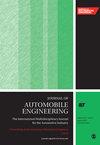An adaptive backstepping control strategy based on radial basis function neural networks for the magnetorheological semi-active suspension
IF 1.5
4区 工程技术
Q3 ENGINEERING, MECHANICAL
Proceedings of the Institution of Mechanical Engineers Part D-Journal of Automobile Engineering
Pub Date : 2024-05-28
DOI:10.1177/09544070241252860
引用次数: 0
Abstract
Owing to nonlinear issues such as external disturbances and uncertain parameters within the semi-active suspension system (SASS), the vibration amplitude of the suspension system tends to increase, and the time required for the suspension system to reach a steady-state response is prolonged. Hence, this paper proposes an adaptive backstepping control strategy based on radial basis function neural networks (RBF-NNs). Firstly, the damping force characteristics of the magnetorheological (MR) damper are tested, and the experimental data are utilized for parameters identification and fitting of the Bouc-Wen model. To establish a connection between the controller and the forward model of the MR damper, the forward model of the MR damper, the inverse model of the MR damper, and the model of the MR-SASS are constructed. Secondly, the backstepping controller and the adaptive backstepping controller based on RBF-NNs are designed. The stability and reliability of the closed-loop suspension system are verified through stability analysis using Lyapunov function. Finally, the dynamic characteristics of the passive control, backstepping control, and adaptive backstepping control strategies based on RBF-NNs applied to MR-SASS are analyzed under B-Class road excitation and speed bump road excitation. The acceleration, suspension dynamic deflection, and tire dynamic load are selected as the evaluation indices. The results demonstrate that the adaptive backstepping controller based on RBF-NNs significantly enhances the ride comfort of the SASS.基于径向基函数神经网络的磁流变半主动悬架自适应反步进控制策略
由于半主动悬架系统(SASS)内部存在外部扰动和不确定参数等非线性问题,悬架系统的振动幅度趋于增大,悬架系统达到稳态响应所需的时间延长。因此,本文提出了一种基于径向基函数神经网络(RBF-NN)的自适应反步进控制策略。首先,测试了磁流变(MR)减振器的阻尼力特性,并利用实验数据进行参数识别和布克-温模型拟合。为了建立控制器与磁流变阻尼器正向模型之间的联系,构建了磁流变阻尼器正向模型、磁流变阻尼器反向模型和磁流变阻尼器-SASS 模型。其次,设计了基于 RBF-NNs 的反求控制器和自适应反求控制器。通过使用 Lyapunov 函数进行稳定性分析,验证了闭环悬挂系统的稳定性和可靠性。最后,在 B 级路面激励和减速带路面激励下,分析了应用于 MR-SASS 的被动控制、反步控制和基于 RBF-NNs 的自适应反步控制策略的动态特性。选择加速度、悬架动态挠度和轮胎动态载荷作为评价指标。结果表明,基于 RBF-NNs 的自适应反步进控制器可显著提高 SASS 的驾乘舒适性。
本文章由计算机程序翻译,如有差异,请以英文原文为准。
求助全文
约1分钟内获得全文
求助全文
来源期刊

CiteScore
4.40
自引率
17.60%
发文量
263
审稿时长
3.5 months
期刊介绍:
The Journal of Automobile Engineering is an established, high quality multi-disciplinary journal which publishes the very best peer-reviewed science and engineering in the field.
 求助内容:
求助内容: 应助结果提醒方式:
应助结果提醒方式:


